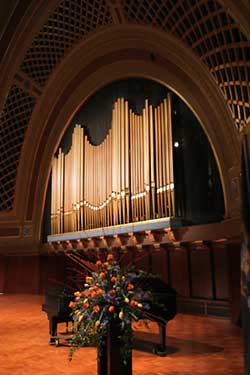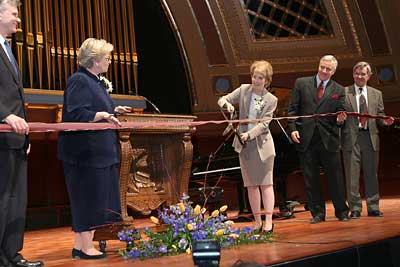Hill Auditorium, venue for countless memorable events throughout much of the last century, was itself at center stage Jan. 8 as it reopened to a crowd that marveled at its restored beauty and elegance.

After 20 months out of the public eye, an opening celebration hosted by President Mary Sue Coleman unveiled the renovated hall to an awestruck crowd of some 2,800 people from the campus and Ann Arbor communities who toured the auditorium and the lobbies restored to their rich original color scheme.
They discovered the newly uncovered architectural details and lights that had been concealed for years by paint, and a new lower lobby constructed in an area that once housed mechanicals. Many were intent on finding “their seats” and locating the new bathroom facilities, as well as taking advantage of the two new elevators.
For Coleman, it was a first-ever look at Hill, which was closed for renovation before she arrived in 2001.
“As I have been waiting for this day to arrive, I have come to realize that Hill Auditorium is more than great architecture—it is an experience,” Coleman told the audience. “It is entire lifetimes of experience, multiplied by tens of thousands of students and audience members.
“It is not just one of the treasures of our University, but a treasure for our country, listed on the National Register of Historic Places.”

During the event, Dean of Music Karen Wolff read stories from many alumni who submitted special memories of the hall, some of whom were in the audience.
“Hill Auditorium has been the public face of the School of Music since its earliest days. Our music alumni have precious memories of the performances they played and heard in this hall,” Wolff said.
“I am so proud today to see the wonderful result of the years of work and planning that have gone into the restoration of this building,” she said.
The restored hall offers the best of the old and new. First conceived more than 20 years ago, and approved by the Board of Regents in 1999, the project brings the 90-year-old building up to code and makes it handicapped accessible.
The replacement of metal-backed seats with wood-backed seats, the installation of sound and light locks, and the restoration of acoustic panels are designed to preserve and even improve the hall’s acclaimed acoustics. Audiences, long discomfited by the lack of air conditioning and adequate restrooms, will find both have been corrected.
Hill was designed by noted Detroit architect Albert Kahn with Ernest Wilby. Albert Kahn Associates, successor to the original Kahn firm, served as project architect for the renovation, and Quinn Evans Architects of Ann Arbor is the preservation architect. With the exception of minor improvements, the four-story brick and stone building had been renovated only once before, in 1949. The layout and the mechanical systems dated to the 1913 original.
The original Kahn design featured a rich polychrome color scheme accenting decorative plaster medallions that frame the stage and outline the parabolic ceiling. That interpretation of an arts and crafts treatment has been restored in earth tones of warm grays, blues, blue-grays, green-grays, golds and deep red-browns. They incorporate, true to Kahn’s plan, a subtle display of the maize and blue University colors.

“These colors are so beautiful—and I was amazed to learn this week that the architect, Albert Kahn, was color-blind,” Coleman said. “So we all are enjoying this hall in a way he never could have.”
More than 300 lights concealed behind paint for decades now illuminate the house, most dramatically in a string of pearls of 136 ceiling lights surrounding the laylight. Period lighting fixtures and carpeting were installed throughout the building, and the color palette was restored in the lobbies.
A new 4,500-square-foot lower lobby with a concession area adds space for socializing and refreshments and houses a rotating display of items from the Stearns Collection of Musical Instruments. Two new monumental staircases connect the main floor to the new lower lobby.
A long list of notables has appeared at Hill, including conductors and singers Leonard Bernstein, Eugene Ormandy, Enrico Caruso and Luciano Pavarotti; musicians Sergei Rachmaninoff and Yo-Yo Ma; and speakers Robert Frost and Cornel West.

Many members of the community cherish personal memories of participating in commencements, school plays and other events in Hill, including Judith Dow Rumelhart, chair of the restoration committee and master of ceremonies for the reopening.
“I remember coming here as a young girl with my family, when I was an aspiring singer,” Dow Rumelhart said. “Every performer I heard taught me a lesson about music and about performing. Like so many of you, I have heard legendary musicians on this stage.”
The University Musical Society (UMS), which has been instrumental in creating Hill’s reputation for showcasing outstanding talent, will commemorate its 125th anniversary this year beginning with events Jan. 17-19.
“We would not be the distinctive organization we are today were it not for Hill Auditorium,” said UMS President Ken Fischer. “Indeed, it is Hill’s two most special features, its large size and its marvelous acoustics, that have enabled UMS to become a presenting organization known and respected throughout the world.”
Other features of the facility include:
• Sound and light locks, including an inner lobby on the first level added to dampen noise from outside the house
• Ventilating equipment was moved from the basement to an addition at the north end to minimize sound infiltration in the house
|
• Two elevators were installed and barrier-free seating increased from six to 38 spaces on the orchestra and mezzanine levels. A ramping system and a new cross-aisle on the main level improve circulation and provide access to the stage. The alterations to meet code to achieve access, minimize sound and increase lobby space reduced the house capacity from 4,169 to 3,600 seats
• Air conditioning, sprinkler and fire alarm systems were provided, and audiovisual systems, performance lighting, house lighting, power and communications systems were replaced
• The organ display pipes at the back of the stage have been restored to the gold bronze color of their first installation in Hill. The terracotta, limestone and brick exterior was repaired and the geometrically patterned tapestry brick plaza fronting the main entrance was rebuilt and restored
• Above the ceiling, catwalks were installed to improve safety and allow better access for maintenance, such as lighting.
Associate Vice President for Facilities and Operations Henry Baier oversaw the project for the University. The U-M construction team from Plant Extension included Marina Roelofs, director; Doug Hanna; Jan Sawyer; Jerry Schulte; Julie Truettner; and Tom Whitaker. The project team also consisted of: architect-of-record, Albert Kahn Associates Inc.; design architect, Quinn Evans Architects; interior decoration, Mariuca Brancoveanu; theater consultant, Fisher Dachs Associates; acoustic consultant, Kirkegaard Associates; lighting designer, Gary Steffy Lighting Design; construction manager, The Christman Co.
The restoration and renovation cost $40 million. A gift from the family of Elizabeth Earhart Kennedy supported the construction of the new lower level lobby.
Coleman acknowledged the donors, including five past U-M presidents; the Board of Regents for approving the project five years ago; and the University staff and outside contractors who worked on the project.
“I know this represents more than a job and more than the hours they have spent here. This hall is the ultimate expression of the term, labor of love,'” she said.
“Everywhere I look, I see the pride they have invested in all the large and miniature aspects that make this such a remarkable building. The high level of craftsmanship is extraordinary, and can be found from the stunning skylight to the meticulous details that surround us.”

